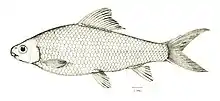Cirrhinus molitorella
Cirrhinus molitorella (mud carp or dace) is a species of ray-finned fish in the genus Cirrhinus found mainly in southern China and Vietnam.
| Mud carp | |
|---|---|
 | |
| Scientific classification | |
| Kingdom: | Animalia |
| Phylum: | Chordata |
| Class: | Actinopterygii |
| Order: | Cypriniformes |
| Family: | Cyprinidae |
| Subfamily: | Labeoninae |
| Genus: | Cirrhinus |
| Species: | C. molitorella |
| Binomial name | |
| Cirrhinus molitorella (Valenciennes, 1844) | |
| Synonyms | |
| |
History
The mud carp is a native Asian freshwater fish with a broad distribution from the Mekong River to the Pearl River deltas, inhabiting lakes, rivers and reservoirs.
Mud carp cultivation was introduced to China during Tang dynasty (618–907 AD) as a substitute for Common carp as the common carp was forbidden to fish due to a ban.[2]
Habitat
The mud carp is found in Mekong River and Pearl River delta, as well as bodies of freshwater along these two rivers.
The fish has been introduced to Indonesia, Singapore, Japan, Taiwan, and Hong Kong.[2]
Within China the fish is raised on fish farms.
Dispersion
Mekong River, Chao Phraya River, Mae Klong River and Tapee River Basin in the south of Thailand
Utilization
Fishery: Trade; Aquaculture: Trade
Diet
Mud carp is an omnivore and mainly consumes water plants or insects. Farm raised carp are fed pellets.
Food
Due to low cost of production, the fish is mainly consumed by the poor and locally consumed; it is mostly sold live and eaten fresh, but can be dried and salted.[2] Increase of hunting has threatened the number of mud carp.[1]
The fish is sometimes canned (typically as fried dace with salted black beans) or processed as fish cakes, fish balls [3] or dumplings. They can be found for retail sale within China and throughout the Chinese diaspora.[2] Canned dace from China has periodically been found to carry traces of malachite green, a carcinogenic antimicrobial banned for use in food.[4][5][6]
See also
References
- Nguyen, T.H.T.; Van, N.S.; Thinh, D.V. (2011). "Cirrhinus molitorella". The IUCN Red List of Threatened Species: 2011: e.T166016A6168828. doi:10.2305/IUCN.UK.2011-1.RLTS.T166016A6168828.en.
- Z., Xinping (7 April 2006). "Cultured Aquatic Species Information Programme. Cirrhinus molitorella". FAO Fisheries Division [online]. Rome: FAO Fisheries Division. Retrieved 5 September 2020.
- "Carp Family". Clovegarden.
- "Detention Without Physical Examination of Aquacultured, Shrimp, Dace, and Eel from China-Presence of New Animal Drugs and/or Unsafe Food Additives". United States FDA. 2020-09-30. Retrieved 2020-11-10.
- "CFS finds traces of malachite green in two tinned fried dace samples" (Press release). Hong Kong. Hong Kong Centre for Food Safety. 2015-08-29. Retrieved 2020-11-11.
- "CFS finds traces of malachite green in canned fried dace sample" (Press release). Hong Kong. Hong Kong Centre for Food Safety. 2019-09-19. Retrieved 2020-11-11.
- Froese, Rainer and Pauly, Daniel, eds. (2006). "Cirrhinus molitorella" in FishBase. April 2006 version.
